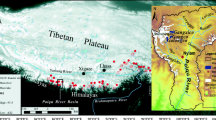Abstract
The Wenchuan earthquake, measured at M s 8.0 according to the China Earthquake Administration, occurred at 14:28 on 12 May 2008 in the Sichuan Province of China. It brought overwhelming destruction to eight provinces and cities. Landslides and rock avalanches triggered by the earthquake produced 257 landslide lakes which were distributed along the fault rupture zone and river channels. The authors traveled to the disaster zone immediately after the earthquake to examine some of the features of the debris dams and performed a quick evaluation of the potential for outburst of earthquake-induced landslide lakes for the purpose of disaster relief. The preliminary analysis indicated that the landslide lakes could be classified as those exhibiting extremely high risk, medium risk, and low risk according to field observations and remote sensing, to determine material composition, dam structure, dam height, maximum water storage capacity, and size of the population potentially affected area. The failure risk of 21 debris dams were evaluated as follows: one dam with an extremely high danger risk, seven dams with a high danger, five dams with a medium danger, and eight dams of low danger. More concern was given to the Tangjiashan Lake and different scenarios for the potential sudden failure of its dam were assessed. The risk evaluation result was accepted in full, by the earthquake disaster relief office. A successful emergency dam treatment for risk reduction was planned, based on our assessments, and these measures were quickly carried out. According to this research, the earthquake destabilized the surrounding mountains, resulting in a prolonged geohazard for the area. Landslides and debris flows will continue to develop for at least 5 to 10 years after the Wenchuan earthquake and will produce additional dammed lakes. Recommendations and plans for earthquake–landslide lake mitigation were proposed, based on past successful practices.










Similar content being viewed by others
References
Casagli N, Ermini L, Rosati G (2003) Determining grain size distribution of the material composing landslide dams in the Northern Apennines: sampling and processing methods. Eng Geol 69:83–97
Chai HJ, Liu HC, Zhang ZY (1995) The catalog of Chinese landslide dam events. J Geol Hazards Environ Preserv 6(4):1–9 (in Chinese)
Chai HJ, Liu HC, Zhang ZY (2000a) The temporal–spatial distribution of damming landslides in China. J Mt Sci 18(Supplement):51–54 (in Chinese)
Chai HJ, Liu HC, Zhang ZY, Wu ZW (2000b) The distribution, causes and effects of damming landslides in China. J Chengdu Inst Technol 27:1–19 (in Chinese)
Clague JJ, Evans SG (1994) Formation and failure of natural dams in the Canadian Cordillera. Geological Survey of Canada Bulletin 464. Geological Survey of Canada, Ottawa
Costa JE, Schuster RL (1988) The formation and failure of natural dams. Geol Soc Amer Bull 100:1054–1068
Costa JE, Schuster RL (1991) Documented historical landslide dams from around the world. U.S. Geological Survey Open-File Report 91-239. U.S. Geological Survey
Cui P, Liu SQ, Tang BX et al (2003) Debris flow prevention pattern in national parks. Sci China Ser E 46(Supp):1–11
Cui P, Wei FQ, He SM et al (2008) Geo-hazards and countermeasures in 5.12 Wenchuan Earthquake Area. Bull Chin Acad Sci 23(4):317–323 (in Chinese)
Dai FC, Lee CF, Deng JH, Tham LG (2005) The 1786 earthquake-triggered landslide dam and subsequent dam-break flood on the Dadu River, southwestern China. Geomorphology 65:205–221
Dunning SA, Petley DN, Strom AL (2005) The morphologies and sedimentology of valley confined rock-avalanche deposits and their effect on potential dam hazard. In: Hungr O, Fell R, Couture R, Eberhardt E (eds) Proceeding of the international conference on landslide risk management.. Balkema, London, pp 691–704
Ermini L, Casagli N (2003) Prediction of the behavior of landslide dams using a geomorphological dimensionless index. Earth Surf Processes Landf 28:31–47
Fread DL (1977) The development and testing of a dam-break flood forecasting model. In: Proceedings of dam-break flood routing model workshop held in Bethesda, MD. Water Resour. Couns., Washington, D.C. pp 164–197
Hewitt K (1982) Natural dams and outburst floods of the Karakoram Himalaya. In: Glen J (ed) Hydrological aspects of Alpine and high mountain areas. Proceedings of the Exeter, England, Symposium, July 1982, IAHS publication no. 138. IAHS, Wallingford, pp 259–269
Kallen D, Xiang W, Rohn ED (2006) Landslides at Qingjiang river in the downstream area of Shuibuya dam site, China. J China Univ Geosci 17(2):158–162
Korup O (2004) Geomorphometric characteristics of New Zealand landslide dams. Eng Geol 73:13–35
Shang Y, Yang Z, Li L, Liu D, Liao Q, Yangchun W (2003) A super-large landslide in Tibet in 2000: Background, occurrence, disaster, and origin. Geomorphology 54:225–243
Sichuan Seismological Bureau (1983) Diexi earthquake in 1933. Science and Technology Press of Sichuan, Chengdu (in Chinese)
Xu XW, Wen XZ, Ye JQ et al (2008) The MS 8.0 Wenchuan earthquake surface ruptures and its seismogenic structure. Seismology and Geology 30(3):597–629 (in Chinese)
Yi GX, Wen XZ, Wang SW et al (2006) Study on fault sliding behaviors and strong-earthquake risk of the Longmenshan–Minshan fault zones from current seismicity parameters. Earthq Res China 22(2):117–125 (in Chinese)
Zhu PY, Li T (2001) Flash flooding caused by landslide dam failure. ICIMOD Newsletter No. 38. Available at http://www.icimod.org.np/ publications/newsletter/New38/dam.htm
Acknowledgments
This research was supported by State Key Fundamental Research Program project (2008CB425802), and the Knowledge Innovation Project of the Chinese Academy of Sciences (No. KZCX2-YW-302). The authors acknowledge the contributions of Prof. Fangqiang Wei, Prof. Siming He, Prof. Yong You, and Mr. Zhan-lu Li for their involvement in the field investigations and thanks to the Prof. Zunlan Chen and Prof. Xiaogang Zhang for their discussion on the earthquake lakes grading. The authors also appreciate Ms. Heidi D. Stenner, Exponent, USA, for her kind help in revising the manuscript.
Author information
Authors and Affiliations
Corresponding author
Rights and permissions
About this article
Cite this article
Cui, P., Zhu, Yy., Han, Ys. et al. The 12 May Wenchuan earthquake-induced landslide lakes: distribution and preliminary risk evaluation. Landslides 6, 209–223 (2009). https://doi.org/10.1007/s10346-009-0160-9
Received:
Accepted:
Published:
Issue Date:
DOI: https://doi.org/10.1007/s10346-009-0160-9




